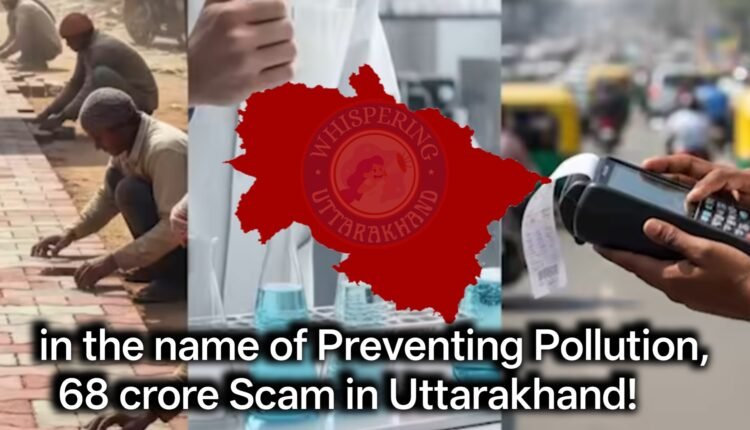The biggest exposure of the system – road tiles, challan machines, and water labs swallowed the funds meant for clean air!
A massive air scam has taken place in Uttarakhand, and no one is talking about it.
Just look at the three things on your screen — road tiles, challan (fine) machines, and a water lab.
Do you know what’s common between them? The ₹68 crore that was supposed to purify the air you breathe these three swallowed it all!
And today, I will show you data and numbers that will shake you to the core…
Namaskar, you are watching
In 2019, the Central Government, seeing the growing air pollution, selected 133 cities across India to control air pollution so that no other city becomes like Delhi.
This program was called the National Clean Air Programme (NCAP).
Among those 133 cities, Uttarakhand was also included, with three cities selected- Dehradun, Rishikesh, and Kashipur.
The Centre released a hefty budget, out of which ₹85.62 crore was allocated to Uttarakhand.
Now see how that money was divided-
Dehradun Municipal Corporation – ₹58.68 crore
RTO – ₹1.6 crore
Pollution Control Board- ₹3.53 crore
Total: ₹63.81 crore
Rishikesh – Municipal Corporation ₹8.15 crore, Pollution Board ₹3.52 crore
Total: ₹12.200 crore
Kashipur – Municipal Corporation ₹8.14 crore, ARTO ₹0.46 crore, Pollution Board ₹0.59 crore
Total: ₹9.19 crore
Agriculture Department- ₹0.4 crore
Now, what happened next is what needs attention.
When it came time to spend the money, departments did work that had absolutely nothing to do with reducing pollution.
First, look at the Municipal Corporation’s act- they used crores of rupees to install tiles along roadsides, claiming it would prevent dust from flying.
They even bought sweeping machines for cleaning.
But officials failed to understand that the coarse dust on roads and the fine, toxic particles in the air (PM2.5 and PM10) are entirely different things.
The particles that settle quickly are coarse and usually larger than PM10, and they are not the main cause of air pollution.
So, in short, putting tiles along roads doesn’t reduce air pollution — it was just a wasteful spending spree.
Now, let’s talk about the Transport Department.
You might think they used the funds to open pollution testing centers or promote electric vehicles.
But no
they used the money to buy challan (fine) machines.
Funds meant to curb pollution from vehicles were instead used to collect fines for traffic violations.
Next, the Agriculture Department, they got ₹40 lakh to research stubble burning pollution (parali).
The shocking part? Uttarakhand never had a major stubble burning issue like Punjab or Haryana!
Money was spent on something that doesn’t even exist here.
And now, the Pollution Control Board the very body responsible for reducing pollution
used the funds meant for air purification to build a water testing laboratory in its headquarters!
Here’s where all the money went:
Dehradun Municipal Corporation – ₹48 crore spent
Rishikesh Municipal Corporation – ₹5.5 crore spent
Kashipur Municipal Corporation – ₹6.3 crore spent
Together, all departments spent a total of ₹68 crore.
Now, let’s see if the air has actually become cleaner after spending these ₹68 crore.
But first, let’s recall the air quality standards:
PM10 should not exceed 100 µg/m³ in 24 hours
PM2.5 should not exceed 60 µg/m³
Now look at the data-
Dehradun: PM10 above 130, PM2.5 around 68
Rishikesh: PM10 above 100, PM2.5 around 50
Kashipur: PM10 above 130, PM2.5 above 80
So this is the full account of ₹68 crore and the question of our future.
If you want to see what happens when we ignore pollution, look at Delhi
the city that turns into a gas chamber every winter.
The AQI in some Delhi areas now touches 500–1000.
So, the big question-
Will we allow Uttarakhand to become the next Delhi?
Because our PM2.5 levels are rising, our AQI is falling, and the number of vehicles is increasing every year.
Yes, green cover is increasing but only on paper.
If we don’t act now, then in 5–7 years, Dehradun will become a mini Delhi.
So who is responsible for wasting ₹68 crore?
And will Uttarakhand ever have a separate Himalayan Policy-
one that controls pollution and also gives people employment?

